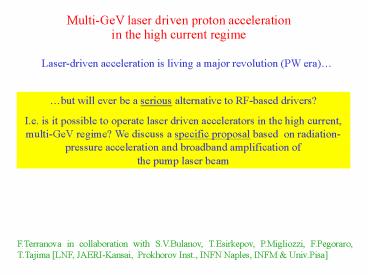Multi-GeV laser driven proton acceleration - PowerPoint PPT Presentation
Title:
Multi-GeV laser driven proton acceleration
Description:
We discuss a specific proposal based on radiation-pressure acceleration and ... Hence the plasma becomes less and less trasparent (more and more overcritical) ... – PowerPoint PPT presentation
Number of Views:110
Avg rating:3.0/5.0
Title: Multi-GeV laser driven proton acceleration
1
Multi-GeV laser driven proton acceleration in the
high current regime
Laser-driven acceleration is living a major
revolution (PW era)
but will ever be a serious alternative to
RF-based drivers? I.e. is it possible to operate
laser driven accelerators in the high current,
multi-GeV regime? We discuss a specific proposal
based on radiation-pressure acceleration and
broadband amplification of the pump laser beam
F.Terranova in collaboration with S.V.Bulanov,
T.Esirkepov, P.Migliozzi, F.Pegoraro, T.Tajima
LNF, JAERI-Kansai, Prokhorov Inst., INFN
Naples, INFM Univ.Pisa
2
Why laser acceleration?
- Well known facts
- The absence of breakdown threshold allows to
reach field gradients much higher than ordinary
RF (gtgt TV/m!) - Acceleration is nearly istantaneous no need of
periodic lattices and long term stability
condition - Forget about multipole instabilities but do not
forget about hydrodynamic ones (e.g.
Rayleigh-Taylor)
- Less known facts
- Potential synergy with Inertial Confined Nuclear
Fusion (ICF) for - Proof of principle of new acceleration regimes
- High intensity on target (1-5MJ _at_ 10 Hz)
3
Three major difficulties
- An efficient, stable and tunable acceleration
mechanism is not available, yet
how?
- Ultra-intense lasers have very low repetition
rates (ltlt 1Hz)
- Targetry (ion source) is complicated
Our basic claim Inefficiency and lack of
tunability comes from the fact that acceleration
is due only to space charge effects but what
happens at laser intensities (1023 W/cm2) where
radiation pressure dominates? System is
self-stabilizing and highly efficient
4
The radiation-pressure dominated regime
x
l
E?
ve?B?cE?
ions
electrons
E?gt E gt mp?/2?e
E2?enel
Independent of xif pulse weist sufficiently large
Avoid ion recombination
() S.V. Bulanov et al., Plas. Phys. Rep. 30
(2004) 196
Ions become relativisticin less than one laser
cycle
5
Space charge acts as a field rectifier
Dynamics of the laser-plasma system
As the ion-electron bounded system moves more and
more rapidly, in its proper frame the incident
laser wavelength increases (Doppler shifted).
Hence the plasma becomes less and less trasparent
(more and more overcritical). As a consequence,
the amount of reflected light increases with time
(maximum momentum transfer).
l
incident
v?c
electrons
ions
g (1? ? 2)-1
mirror !
reflected
6
Dynamics of the laser-plasma system
The driving light pressure is P (E2L/4?)(1
r2-t2) (E2L/4?) (w/w)2 r(w)2 and w
is the light frequency in the mirror frame ?
r(w)2 (mirror reflectance) grows with time. If
we compute the maximum ion energy, accounting for
the finite pulse duration we get that the energy
increses as t1/3 and we have
and if the laser energy is gtgt with respect to the
overall rest mass of the protons
- The number of protons depends only on the size
of the illuminated area of the target - The energy depends linearly on the laser
intensity and its duration - This is the tunability we were looking for !!
7
OK. But does it really work? It seems so.
Numerically().
Tested at a316 (peak intensity of 1023 W/cm2),
ll1mm, ne5.5 1022 cm-3
() T. Esirkepov et al., Phys. Rev. Lett. 92
(2004) 175003
test of the mirror dynamics (e.g. t1/3
asymptotic behaviour)
Laser ion energy transfer efficiency of about 50
This is the light-to ion transfer efficiency we
were looking for !!
8
A very unexpected synergy with Inertial Confined
Fusion (ICF)!
The pressure dominated regime bridges for the
first time the RD done for huge laser-matter
energy transfer connected with Inertial Confined
Fusion with the one for high power proton drivers
S.V.Bulanov et al., Nucl.Instrum.Meth. 540
(2005) 25
Can we really exploit high rep-rate ICF ?
All viable candidates (Excimer lasers,
Diode-pumped solid state lasers) provide a small
bandwidth, high intensity pump pulse. We cannot
achieve 10 fs pulse compression directly!
Huge pump with small bandwidth
Idler
Amplifier (OPCPA?)
Faint (chirped) signal with large bandwidth
Broadband amplified signal
9
Can we really exploit high rep-rate ICF ?
There are region of compatibility for efficient
OPCPA amplifications and high rep rate drivers
(DPSSL and XeF, not KrF)
Preliminary
Anyway, a proof of principle could be done at
early light (1 beamlet of NIF) with
traditional pulse compression techniques
(CPA) (based on an idea of T. Tajima and G.
Mourou, Phys. Rev. ST Acc. Phys. 2003)
10
Conclusions
The radiation pressure dominated regime is (to my
mind!) the first serious proposal for high
intensity laser-driven proton acceleration in the
multi-GeV region. This technique is
- Efficient (50 light to ion conversion)
- Tunable (proton energy decoupled from pulse
width and hence from proton intensity) - Produces beams of good quality even for
injection in lattice
Needless to say
A real synergy with ICF is possible, provided
that pulse compression can be implemented in high
repetition rate drivers (we have good
candidates)































